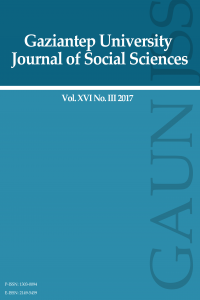Öz
New Historicism, flourishing in the 1980s
as a “new” contemporary literary approach, proposes new viewpoints to the understanding of
history and challenges the conventional understanding of history by pointing
out the private histories. New Historicism deals with the representations of
history rather than the history itself since it believes that there is not one
history but multiple histories. The purpose of this article is to analyze the
representation of history in Kazuo Ishiguro’s When We Were Orphans from the New Historicist viewpoint by focusing
on the concepts of time, memory and narrative technique, hence to reveal how
history is narrated in subjective multiple ways and how personal histories and
public histories are intermingled.
Anahtar Kelimeler
New Historicism representation of history historicity of texts textuality of history memory
Kaynakça
- Greenblatt, Stephen (2005). Renaissance Self-fashioning: From More to Shakespeare. Chicago: The University of Chicago P. Print.
- Greenblatt, Stephen (1990). Shakespearean Negotiations: The Circulation of Social Energy in Renaissance England. Oxford: Clarendon Press. Print.
- Ishiguro, Kazuo (2000). When We Were Orphans. London: Faber &Faber. Print.
- Jameson, Fredric (1993). Postmodernism, or, The Cultural Logic of Late Capitalism. Durham: Duke UP. Print.
- Janik, Del Ivan (1989). “History and the ‘Here and Now’: The Novels of Graham Swift.” Twentieth-Century Literature 35: 74-88. 27.08.2014. Print.
- Kazuo Ishiguro and Oe Kenzaburo (1991), ‘The Novelist in Today’s World: A Conversation’, Boundary, 18/3: p.115. Print.
- Lewis, Barry (2000). Kazuo Ishiguro: Contemporary World Writers. Manchester UP. Print.
- Mackenzie, Suzie (25 March 2000). “Between Two Worlds.” Guardian Weekend. 10 April 2015. Web.
- Nora, Pierre (Spring, 1989). “Between History and Memory.” Representations, No. 26, Special Issue: Memory and Counter-Memory. pp. 7-24. JSTOR. Web. 18.02.2014.
- Ristaino, Marcia R (1987). China's Art of Revolution: The Mobilization of Discontent, 1927 and 1928. Durham: Duke University Press. Print.
- Shaffer, Brian W. and Cynthia F. Wong. (eds.) (2008) Conversations with Kazuo Ishiguro. Mississippi: Mississippi UP. Print.
- Veeser, H. Aram (1989). The New Historicism. New York: Routledge. Print.
- Mackenzie, Suzie (25 March 2000). “Between Two Worlds.” Guardian Weekend. 10 April 2015.
- Mason, Gregory (1989). “An Interview with Kazuo Ishiguro.” Contemporary Literature 30: 334-47.
- Montrose, Louis A. (1989). “Professing the Renaissance: The Poetics and Politics of Culture” The New Historicism. Ed. H. Aram Veeser. New York: Routledge.
- Nora, Pierre (Spring, 1989). “Between History and Memory.” Representations, No. 26, Special Issue: Memory and Counter-Memory. pp. 7-24. JSTOR. 18.02.2014.
- Ristaino, Marcia R (1987). China's Art of Revolution: The Mobilization of Discontent, 1927 and 1928. Durham: Duke University Press.
- Shaffer, Brian W. and Cynthia F. Wong (2008). Conversations with Kazuo Ishiguro. Mississippi: Mississippi UP.
- Lewis, Barry (2000). Kazuo Ishiguro: Contemporary World Writers. Manchester UP.
Öz
1980’li
yılların ortasında “yeni” bir edebi teori/yaklaşım olarak ortaya çıkan Yeni
Tarihselcilik kuramı tarih anlayışına yeni bakış açıları sunmaktadır ve öznel
tarih anlayışlarına vurgu yaparak geleneksel tarih anlayışına meydan
okumaktadır. Yeni Tarihselcilik akımı tek bir tarih olmadığına ve çoklu tarih
anlayışına inandığı için tarihin kendisiyle değil tarih(ler)in nasıl temsil
edildiği ile ilgilenmektedir. Bu makalenin amacı Kazuo Ishiguro’nun Çocukluğumu
Ararken adlı romanına Yeni Tarihselcilik edebi teorisi/yaklaşımı
çerçevesinde zaman, bellek ve anlatım tekniği kavramlarına değinerek tarih
temsilini incelemek ve böylece tarihin çeşitli öznel temsilleri ile kişisel ve
genel tarihin nasıl iç içe geçtiğini ortaya çıkartmaktır.
Anahtar Kelimeler
Yeni Tarihselcilik tarih temsili metnin tarihselleşmesi tarihin metinselleşmesi bellek Kazuo Ishiguro
Kaynakça
- Greenblatt, Stephen (2005). Renaissance Self-fashioning: From More to Shakespeare. Chicago: The University of Chicago P. Print.
- Greenblatt, Stephen (1990). Shakespearean Negotiations: The Circulation of Social Energy in Renaissance England. Oxford: Clarendon Press. Print.
- Ishiguro, Kazuo (2000). When We Were Orphans. London: Faber &Faber. Print.
- Jameson, Fredric (1993). Postmodernism, or, The Cultural Logic of Late Capitalism. Durham: Duke UP. Print.
- Janik, Del Ivan (1989). “History and the ‘Here and Now’: The Novels of Graham Swift.” Twentieth-Century Literature 35: 74-88. 27.08.2014. Print.
- Kazuo Ishiguro and Oe Kenzaburo (1991), ‘The Novelist in Today’s World: A Conversation’, Boundary, 18/3: p.115. Print.
- Lewis, Barry (2000). Kazuo Ishiguro: Contemporary World Writers. Manchester UP. Print.
- Mackenzie, Suzie (25 March 2000). “Between Two Worlds.” Guardian Weekend. 10 April 2015. Web.
- Nora, Pierre (Spring, 1989). “Between History and Memory.” Representations, No. 26, Special Issue: Memory and Counter-Memory. pp. 7-24. JSTOR. Web. 18.02.2014.
- Ristaino, Marcia R (1987). China's Art of Revolution: The Mobilization of Discontent, 1927 and 1928. Durham: Duke University Press. Print.
- Shaffer, Brian W. and Cynthia F. Wong. (eds.) (2008) Conversations with Kazuo Ishiguro. Mississippi: Mississippi UP. Print.
- Veeser, H. Aram (1989). The New Historicism. New York: Routledge. Print.
- Mackenzie, Suzie (25 March 2000). “Between Two Worlds.” Guardian Weekend. 10 April 2015.
- Mason, Gregory (1989). “An Interview with Kazuo Ishiguro.” Contemporary Literature 30: 334-47.
- Montrose, Louis A. (1989). “Professing the Renaissance: The Poetics and Politics of Culture” The New Historicism. Ed. H. Aram Veeser. New York: Routledge.
- Nora, Pierre (Spring, 1989). “Between History and Memory.” Representations, No. 26, Special Issue: Memory and Counter-Memory. pp. 7-24. JSTOR. 18.02.2014.
- Ristaino, Marcia R (1987). China's Art of Revolution: The Mobilization of Discontent, 1927 and 1928. Durham: Duke University Press.
- Shaffer, Brian W. and Cynthia F. Wong (2008). Conversations with Kazuo Ishiguro. Mississippi: Mississippi UP.
- Lewis, Barry (2000). Kazuo Ishiguro: Contemporary World Writers. Manchester UP.
Ayrıntılar
| Konular | Sanat ve Edebiyat |
|---|---|
| Bölüm | İngiliz Dili ve Edebiyatı |
| Yazarlar | |
| Yayımlanma Tarihi | 31 Temmuz 2017 |
| Gönderilme Tarihi | 7 Şubat 2017 |
| Yayımlandığı Sayı | Yıl 2017 Cilt: 16 Sayı: 3 |


